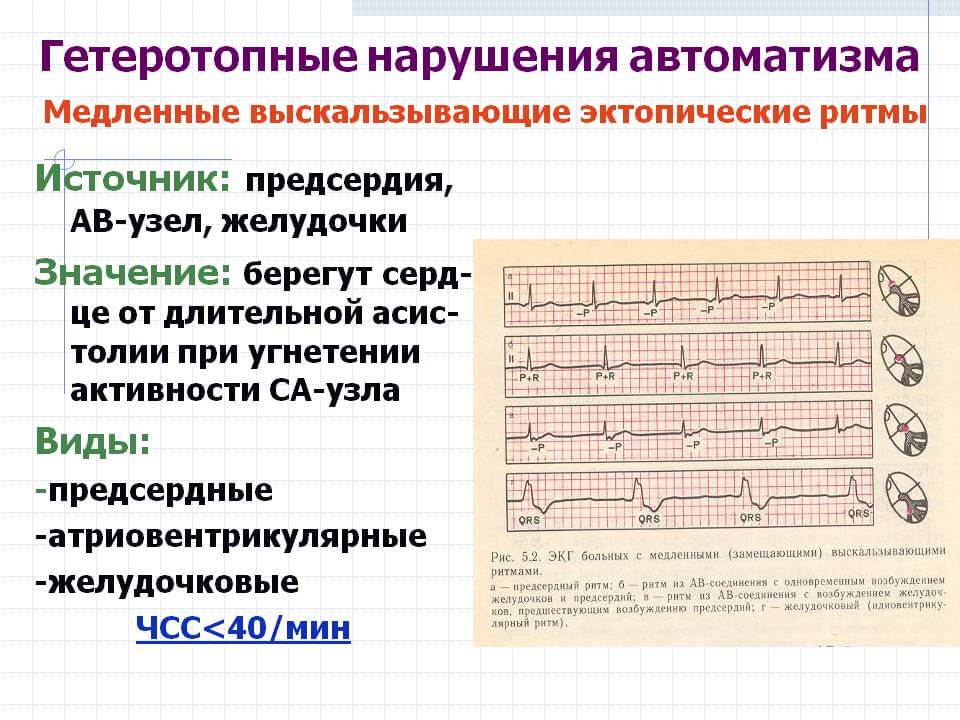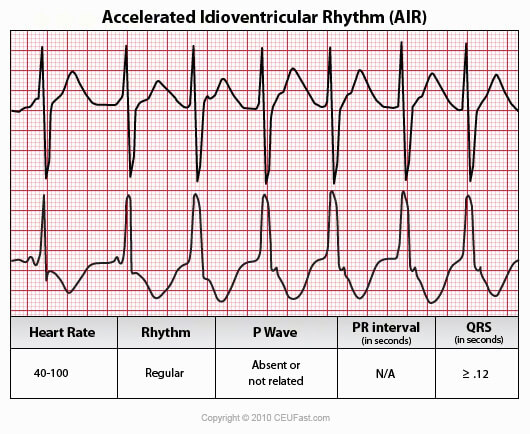Heterotropic arrhythmias
Author Ольга Кияница
2017-11-10
Arrhythmias are a cardiac pathology, which is accompanied by a change in the frequency of heart rate. A heart rate sequence may also be violated. In any case, at arrhythmias, a disorder of the electrophysiological functions of the myocardium is observed
Conduction disturbances and heart rhythm lead in 10-15% of cases to cardiac diseases causing cardiac arrest
The appearance of arrhythmias is associated with various causes, organic and functional. Violation of the rhythm may be observed in infancy, which indicates an inborn anomaly, as well as in adults. Particularly arrhythmias are affected by elderly people, who most often identify cardiac pathologies that contribute to arrhythmias: IHD, cardiosclerosis, myocarditis, heart failure.
Video work of the heart
Description of heterotopic arrhythmias
Heterotropic arrhythmias belong to a group of disorders of automatism. This property of the myocardium is the ability to be excited by the action of potentials spontaneously arising therefrom. Automatically related electrical processes are carried out in atypical cardiomyocytes. A group of such cells forms a rhythm driver - a sinus node.
At heterotropic arrhythmias, the center of automatism moves to the lower parts of the sinus node, with the formation of ectopic rhythms and a violation of the normal flow of rhythmogenesis.
At the heart of formation of heterotropic arrhythmias there are various mechanisms. Some of them are related to the location of the rhythm driver - pacemaker - in the ventricles. Others - with pathological circulation of the excitation wave along the ventricles. There may also be a complete cessation of the transfer of pulses from the atrium to the ventricles, then speak of AB-dissociation.

Symptoms of heterotropic arrhythmias
It manifests itself as all arrhythmias - a heartbeat and a feeling of wrong heart work. Also, patients feel discomfort in the chest, heart pains are possible.
In the presence of an organic pathology of the heart, symptoms such as dizziness, weakness, shortness of breath, an asthma attack are added. Signs that are insignificant at first glance can further provoke more serious cardiac abnormalities or attacks by Morgany-Adams-Stokes.
What are heterotopic arrhythmias? In coronary artery disease, the heart may cause angina pectoris. If the patient has heart failure, then shortness of breath is exacerbated by arrhythmias.
Arrhythmia, arising from functional disorders, is not accompanied by a pronounced clinic. In general, the patient may have no symptoms of the disease. In spite of this, one should not neglect a visit to a cardiologist or arrhythmologist.
Types of heterotopic arrhythmias
There are several typical arrhythmias that refer to heterotropic rhythm disturbances. The most common is the atrioventricular rhythm. Also, the migration of the ventricular driver of the rhythm and the ventricular rhythm, which is also known as idiowentricular, is distinguished.
Atrioventricular rhythm
It is also designated as nodal, since it is within the limits of an atrioventricular node of impulse transmission. Similar arrhythmias are formed with insufficient work of the main pacemaker, which begins to generate weak signals or even ceases to send them. Since in the nodal driver the rhythm impulses even in the normal state are transmitted more slowly, then with their generation, also a smaller heart rate is noted - 40-60 per minute.

Finding a pulse generator in an atrioventricular node is directly related to heart rate, so the lower it is located, the less the frequency of heart contractions.
"Atrial closure" is dangerous because it can cause acute heart failure. Also, severe circulatory disorder at the nodal rhythm of cerebral ischemia is manifested by dizziness, fainting and, in difficult cases, loss of consciousness.
Migration of the ventricular driver of rhythm
The formation of this type of rhythm disturbance is associated with the onset of sinus-atrial node automatism due to the periodic effects of the vagus nerve. The movement, "migration", of the rhythm driver from the sinus node to the underlying department, that is, the atrioventricular node, is observed. and in the opposite direction.

The location of the new pulse generator directly affects the heart rate. Also, the circulatory system may suffer if the pumping capacity of the heart is significantly impaired.
Migration of the rhythm driver occurs both among adults and children.
Idioventricular (actually ventricular) rhythm
There is a rare and accelerated idiowentricular rhythm.
- The first one is a very severe condition characterized by heart rate 40-10 times per minute. This arrhythmia arises due to reduced activity of superior pulse generators - sinus and atrioventricular nodes. Then a third-person patismaker begins to operate - the bunch of Guillaume. Its power of automatism is much lower compared to the two "older" drivers of the rhythm, so the heart rate is reduced to a catastrophic minimum. Such a work of the heart can not provide normal circulation, therefore, organs and tissues, especially the myocardium and the brain, begin to suffer.
- The second, iijoventricular accelerated rhythm, is formed in the case of a pathological circulation of the pulse in the myocardium. With this pathology, the heart rate is up to 120 times per minute. It is mainly developed during myocardial infarction and is restored without medical intervention in the case of asymptomatic leakage.

Causes of heterotropic arrhythmias
The appearance of arrhythmias is associated with cardial and external causes. Cardiac factors include all diseases that impair the functioning of the cardiovascular system. External causes are very diverse and the heart may have a negative influence, such as smoking, alcoholism, and frequent psycho-emotional disorders.
Depending on the type of heterotopic arrhythmia, the following factors can be distinguished:
- The atrioventricular rhythm develops against the background of cardiosclerosis, ischemic heart disease, and increased exposure to the autonomic nervous system. Contributing to electrolyte disturbances (elevated levels of potassium and magnesium in the blood) and overdose of cardiac glycosides. Arrhythmia can exacerbate the course of heart failure if it goes into a stage of decompensation and there is a strong stretching of the myocardium.
- Migration of the rhythm driver often occurs due to electrolyte disturbances, which in turn are associated with thyroid dysfunction, overdose of diuretics, diabetes mellitus, postoperative period. With the disorder of the autonomic nervous system, this pathology can also be formed.
- Idioventricular rhythm is often associated with infectious and postinfarction states, therefore, with their development, especially during the rehabilitation period, patients are carefully monitored. In some cases, the appearance of an idiopotential rhythm indicates a terminal stage preceding the death of the patient.
Diagnosis of heterotropic arrhythmias
The final diagnosis of the presence of heterotopic arrhythmia is based on an electrocardiographic study.
ECG signs of nodal rhythm:
- the ventricular complex and the tooth P may coincide, or the latter appears on the cardiogram after the QRS complex;
- the root P is defined as negative;
- The AB-rhythm is set up by heart rate, which is 40 to 60 times per minute.
ECG signs of rhythm driver migration:
- the sinatricular block is defined as intermittent;
- the rhythm is most often the right sinus, since the tooth P is positive;
- Periodically there are stops of the sinus node in which the rhythm is subtracted by abbreviations from the atrioventricular node, expressed by the negative tent P before the QRS complex.
ECG signs of iridoventricular rhythm:
- QRS complex expands;
- the tooth P is not related to the QRS complex or is absent at all;
- heart rate 50 and less per minute;
- at one pathological focal point the rhythm is kept correct, and at a few it becomes incorrect.
Treatment and prognosis for heterotropic arrhythmias
For all violations of rhythms, antiarrhythmic drugs are used, which are represented mainly in two groups:
- Direct antiarrhythmic agents affecting the multi-directional channels through which potassium ions, magnesium and the like electrolytes enter. The most famous representatives of this group of arrhythmics are amiodarone, valapenin, rhythmnorm. When administered improperly, the risk of side effects increases.
- Drugs that improve pulses are able to reduce heart rate, so if you have a low heart rate, you should not use it.
In addition to the general treatment of arrhythmias, there are still additional therapies for each type of heterotropic rhythm disorders separately.
- Atrioventricular rhythm is often corrected by sympathetic and vagotropic agents. In most cases, there is a short-term effect of such treatment, therefore, the prognosis with an AV-rhythm is unfavorable.
- Idioventricular rhythm is mainly associated with heart attacks, so their therapy helps restore normal heart function.
- Migration of the rhythm driver can be controlled by arrhythmic drugs, but for the long-term results, the main disease should be treated.
In all cases, with heterotropic arrhythmias, the working capacity of the patient depends on disorders that have arisen in the cardiovascular system.
Prevention of heterotopic arrhythmias
Specific prevention of pathology is absent, therefore, measures of caution for its development are mainly aimed at the treatment of the underlying disease. In general, for all types of arrhythmias it is recommended:
- It is good to eat and rest as needed, not allowing physical or emotional overvoltage.
- To refuse harmful habits, even preventing the possibility of being a passive smoker.
- To undergo sanatorium and spa treatment in specialized institutions.

Если раньше у меня был синусовый ритм, а потом, внезапно поменялся на предсердный ритм с брадикардией (около 50 ударов и удары стали ощущаться как более мощные), можно ли это считать миграцией водителя ритма?
Вероятнее всего изменения возникли либо на фоне гипертонии, либо от физических перегрузок. Возраст – 61, давление 160/90, был пульс около 60, а около 9 месяцев назад пульс резко снизился до 48 – 52 в покое, кардиограмма показала предсердный ритм.
Возможно ли восстановление синусового ритма?